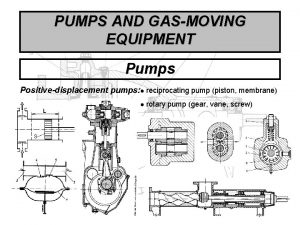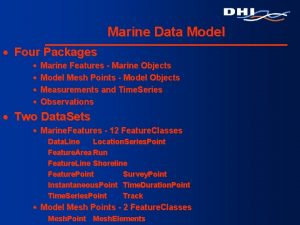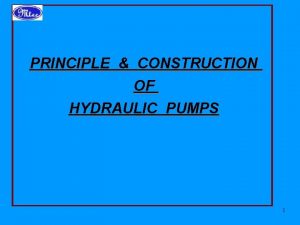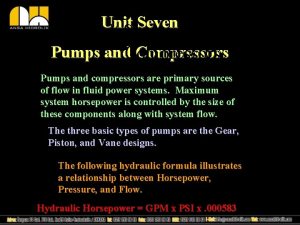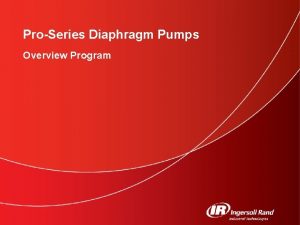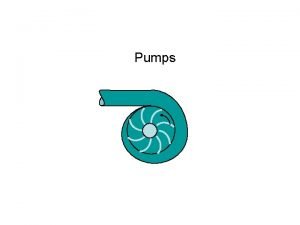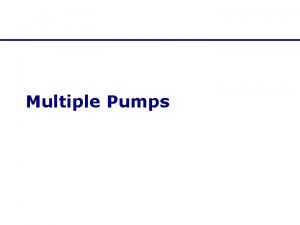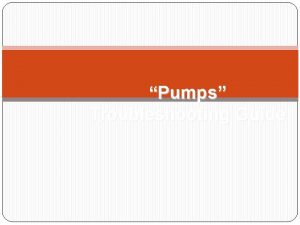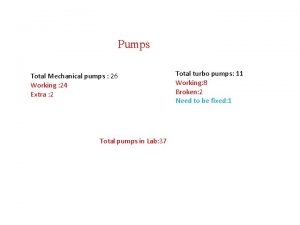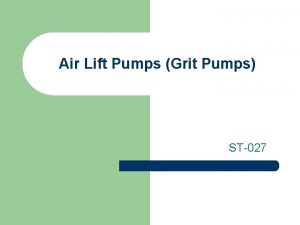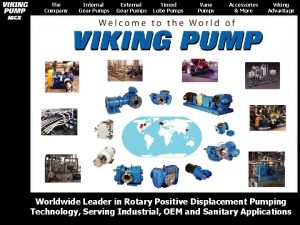Pumps for Marine Applications 4 0 Pumps Pumps


























- Slides: 26

Pumps for Marine Applications 4. 0 Pumps

Pumps for Marine Applications Overview of Lecture • What is a Pump? • Pump Types o Displacement Pump o Axial-Flow Pump o Centrifugal Pump o Ejectors o Submersible Pumps

Pumps for Marine Applications Disclaimer • The topic of PUMPS is substantial enough so as to warrant its own course. In this course, we will only have time to ‘scratch the surface’ of pumps. • What follows is an overview of pumps, with emphasis given to pumps that are used most often in the marine industry.

Pumps for Marine Applications What is a Pump? • A pump is a machine used to raise liquids from a low point to a high point. • Alternatively it may simply provide the liquid with an increase in energy enabling it to flow or build up a pressure.

Pumps for Marine Applications Head Pressure refers to the pressure produced by a vertical column of fluid. • The pump provides the energy to develop the head and overcome any losses in the system. • Losses are mainly due to friction within the pipes and the difference between the initial and final liquid levels.

Pumps for Marine Applications Head Pressure

Pumps for Marine Applications Net Positive Suction Head is the difference between the absolute pump inlet pressure and the vapor pressure of the liquid. Note: Pump location will effect these values.

Pumps for Marine Applications Pump Types There are FIVE main classes of pump in marine use: 1. Displacement -rotary: -reciprocating: -screw: which can handle viscous, nonabrasive liquids which can handle low-solids, low-viscosity liquids. 2. Axial flow: more suited for low heads and higher discharges. 3. Centrifugal: which can handle abrasive, high-solid liquids. 4. Ejector: can be used to aerate sludge, such as heavy oil and sewage. 5. Submersible: does not have a long drive shaft. Most Common

Pumps for Marine Applications Pump Types - Uses Centrifugal Pumps 1. Condensate and feed water pumps for steam power plants. 2. Auxiliary pumps for cooling systems, distilling plants, and tank drainage. 3. Fire fighting pumps for pumping sea water. 4. Sewage pumps 5. Cargo pumps for pumping liquid cargo. 6. Submersible pumps for pumping out tanks

Pumps for Marine Applications Pump Types - Uses Positive Displacement Pumps 1. Fuel transfer 2. Lube oil service 3. Aqueous film forming foam (AFFF) service pumps, which pump a foam and seawater mixture for fire fighting. 4. Proportioning pumps for metering injections of various materials into a system. 5. Bilge pumps 6. Stripping pumps for skimming impure layers in a fuel or oil tank 7. Miscellaneous service pumps

Pumps for Marine Applications Displacement Pump (Reciprocating) Self-Priming — The ability of a pump to purge air from its system and creating an area of low pressure that permits water to flow into the pump casing.

Pumps for Marine Applications Displacement Pump (Rotary) Self-Priming — The ability of a pump to purge air from its system and creating an area of low pressure that permits water to flow into the pump casing.

Pumps for Marine Applications Displacement Pump (Screw) Self-Priming — The ability of a pump to purge air from its system and creating an area of low pressure that permits water to flow into the pump casing. A diagram of an Archimedes screw pump

Pumps for Marine Applications Axial Flow Pump An axial-flow pump uses a screw propeller to axially accelerate the liquid. The outlet passages and guide vanes are arranged to convert the velocity increase of the liquid into a pressure.

Pumps for Marine Applications Axial Flow Pump Ship's Waterjet System

Pumps for Marine Applications Centrifugal Pump

Pumps for Marine Applications Centrifugal Pump Single-entry centrifugal pump Double-entry centrifugal pump

Pumps for Marine Applications Centrifugal Pump Multi-stage centrifugal pump

Pumps for Marine Applications Centrifugal Pump Centrifugal pumps, while being suitable for most general marine duties, are not self priming and require some means of removing air from the suction pipeline and filling it with liquid. Where the liquid to be pumped is at a level higher than the pump, opening an air cock near the pump suction will enable the air to be forced out as the pipeline fills up under the action of gravity. If the pump is below sea water level, and sea water priming is permissible in the system, then opening a sea water injection valve and the air cock on the pump will effect priming.

Pumps for Marine Applications Centrifugal Pump manufacturers now offer Centrifugal Pumps which include automatic priming units. Be sure to select “self priming” when self priming is needed

Pumps for Marine Applications Ejectors An ejector is a form of pump which has no moving parts. A high-pressure liquid or a vapour such as steam discharges from a nozzle as a high -velocity jet and entrains any gases or liquids surrounding the nozzle. The mixture enters a converging-diverging diffuser tube where some of the kinetic energy is converted into pressure energy.

Pumps for Marine Applications Ejectors Effects/Principles - Venturi Effect The Venturi effect is the reduction in fluid pressure that results when a fluid flows through a constricted section of pipe. The Venturi effect is named after Giovanni Battista Venturi (1746– 1822), an Italian physicist.

Pumps for Marine Applications Submersible Pumps • Electro-submersible pumps are turbine pumps that are closecoupled to an electric motor. • The motor and pump are in the one unit with the motor underneath keeping the unit submerged. • The pump is dimensioned for use in bores and is very long in comparison to its diameter. The advantages of the electro-submersible pump are: 1. It does not have a long drive shaft. 2. It may be installed in a misaligned bore. Marine uses include: sewage tanks, cargo oil tanks, and oil wells.

Pumps for Marine Applications Pumps – What to Know MESD professionals should: • have an understanding of how the various types of pumps operate • know which pumps work best for various operational situations • be able to identify the various types of pumps

Pumps for Marine Applications Recap • What is a Pump? • Pump Types o Displacement Pump o Axial-Flow Pump o Centrifugal Pump o Ejectors o Submersible Pumps

Pumps for Marine Applications ANY QUESTIONS?
 Strategi för svensk viltförvaltning
Strategi för svensk viltförvaltning Bris för vuxna
Bris för vuxna Frgar
Frgar Formel gruplar
Formel gruplar Nyckelkompetenser för livslångt lärande
Nyckelkompetenser för livslångt lärande Rutin för avvikelsehantering
Rutin för avvikelsehantering Tack för att ni har lyssnat
Tack för att ni har lyssnat Tidbok för yrkesförare
Tidbok för yrkesförare Klassificeringsstruktur för kommunala verksamheter
Klassificeringsstruktur för kommunala verksamheter Iso 22301 utbildning
Iso 22301 utbildning Påbyggnader för flakfordon
Påbyggnader för flakfordon Tack för att ni lyssnade
Tack för att ni lyssnade Skapa med geometriska former
Skapa med geometriska former Tobinskatten för och nackdelar
Tobinskatten för och nackdelar Egg för emanuel
Egg för emanuel Atmosfr
Atmosfr Verifikationsplan
Verifikationsplan Tack för att ni lyssnade bild
Tack för att ni lyssnade bild Presentera för publik crossboss
Presentera för publik crossboss Rbk fuktmätning
Rbk fuktmätning Varför kallas perioden 1918-1939 för mellankrigstiden?
Varför kallas perioden 1918-1939 för mellankrigstiden? Var 1721 för stormaktssverige
Var 1721 för stormaktssverige Jätte råtta
Jätte råtta Tillitsbaserad ledning
Tillitsbaserad ledning Tack för att ni har lyssnat
Tack för att ni har lyssnat Mall för referat
Mall för referat Sura för anatom
Sura för anatom



























